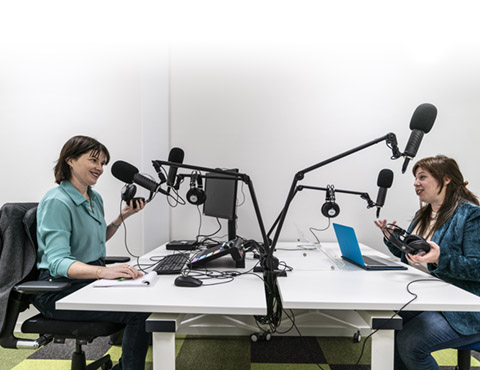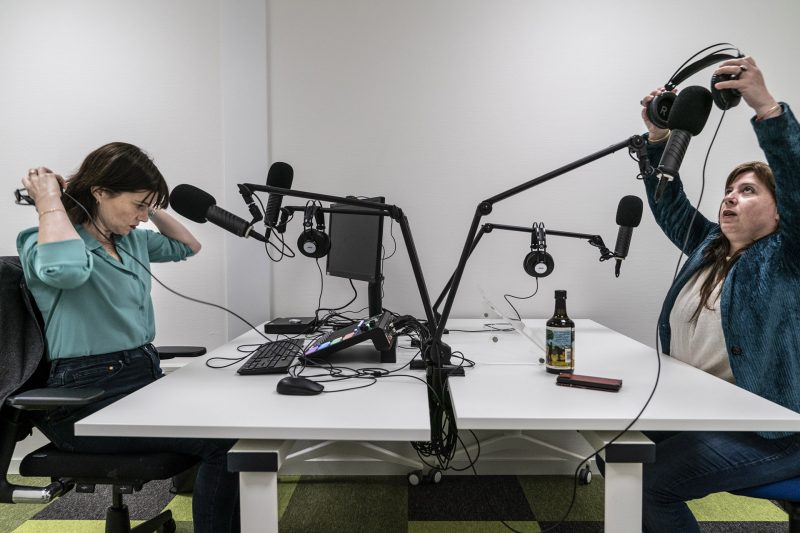
What blended learning has taught us
Smart gadgets and more interaction
The UG wants to get on with it and use the knowledge that lecturers were forced to rapidly learn because everything was done online over the past two years. ‘Blended learning is one of our biggest ambitions in our new strategic plan’, a memo to the university’s faculties says.
The faculties have been working hard on that themselves, says Rutger Klein Nagelvoort, director of education at the department of educational strategy at the university. ‘In part because we’re not done with Covid yet.’
Educational innovation accelerated because of the pandemic. There is a wide variety of initiatives, but they’re spread out across faculties. The UG wants to streamline these initiatives, starting by explaining what exactly blended learning entails.
More discussions and more interaction because some other things are online
One thing it definitely isn’t, Klein Nagelvoort emphasises, is cancelling on-campus education. Classes that people attend in person should be utilised as best as they can be. ‘More discussions and more interaction because some other things are online.’
The Teaching Academy Groningen is currently creating an overview of all the different initiatives, which range from simple online quizzes to the podcast the Faculty of Theology and Religious Studies created.
But how do the lecturers themselves feel about blended learning? Which changes do they like and which gadgets and software will they keep using?
Pigeonhole
Law lecturer Laurent Jensma would prefer no new large-scale innovation projects for a while. ‘Everyone’s worked their butts off the past two years’, he says. On top of that, people are preparing for the next academic year, and they also have to deal with the implementation of Brightspace, the digital environment that’s replacing Nestor. Besides, Jensma already knows his way around ‘all that technical crap’.
However, one positive thing from the past two years would be Pigeonhole. That one can stay, he says. Another program, that does the same, is FeedbackFruits, which collects students’ questions and organises them with the help of votes. This enables lecturers to see which questions you need to go over again during the next seminar, via email, or an online meeting.
This comes in handy especially in lectures attended by hundreds of first-year students, says Jensma. ‘It’s much nicer than having to answer forty different emails all asking essentially the same question.’
FeedbackFruits
Accountancy lecturer Derk Jan Heslinga is also a fan of FeedbackFruits. He uses the program to add to his recorded classes. People retain only a fraction of spoken information, he says, which means rewatching recordings is definitely useful.
But it’s also boring and time-consuming. ‘It’ll easily take up a whole morning: you miss a bit, get distracted, have to rewind. That’s not what it’s for.’
Rewatching a lecture can take all morning
His solution is to cut the lecture down into smaller bits and add to them. ‘That way, students actively engage with the material.’ This helps them learn. So he uses FeedbackFruits to add questions that students have to answer. Students can also ask their own questions.
Rewatching a lecture can really help those students who are motivated, says Heslinga. But he also thinks that for students who aren’t that motivated, lecture recordings can lead to ‘extreme procrastination’.
It’s not that he wants everything to return to how it was, he emphasises. ‘That would be a huge shame.’ But there should be incentives to stimulate active learning, like forcing students to watch a lecture before they’re allowed to attend the seminar. ‘That would be a move towards true blended learning.’
Oikio Cam and Screencast-O-Matic
Heslinga also brings his small Oikio Cam to every class. ‘It’s a great little device’, he says. It essentially functions like an old-fashioned overhead projector, except it’s digital. This makes it a lot more versatile and convenient than those heavy light boxes from way back.
Heslinga also uses it to project documents onto the screen for the students at home. He makes the sheets for his Oikio Cam beforehand, when he’s brainstorming his lesson plan, or he has a student assistant copy what he’s doing on the board and put them under the lens.
He also uses the little camera for his instructional videos, which he records using the online software Screencast-O-Matic. ‘First, the sound’, he emphasises, then the slides. The result is much more tranquil. If you do everything at once, you’re multitasking, which leads to mistakes and your voice starts to sound monotonous, Heslinga explains. That would make the whole thing boring. Now, when he does make a mistake, it’s easier to start over without having to do absolutely everything over again.
Small testing moments
The most important thing that Peter Groote, associate professor of spatial science, has learned from the past two years, he says, pertains to testing. ‘We’ve fundamentally changed the way we do that.’
Open-book exams are still a thing and students are now also allowed to use their notes, laptops, and tablets. That’s a skill they’ll need for the rest of their lives, Groote says. ‘The only thing we said is that they couldn’t use any of it to communicate.’
We’ve fundamentally changed the way we administer tests
Exams have also become shorter and count less towards passing the course. The high stakes form of testing, with the focus on a single testing moment, doesn’t help students learn, says Groote. It mainly causes them stress. As he’s found out over the past two years, ‘students need to feel good in order to learn’.
For his course, students can earn points during small testing moments, for instance by watching an online class. This can be tracked automatically, says Groote. It’s just a matter of setting it up.
He won’t watch his students like a hawk, though. If they only watch the class for a few seconds, that works for him. He just wants them to be active and feel stimulated to engage with the material. ‘Testing should serve as something that contributes to their learning experience.’

Best Practice Award
The UG’s annual Best Practice in Teaching & Learning Award was this year given to the creators of the podcast for the course climate change, end times, sustainability at the Faculty of Theology and Religious Studies.
The podcast, which was created by Erin Wilson, Tina Otten, Linde Draaisma, and Henk van Putten, enables students to prepare for their class every week. Each episode hosts different academics from various fields. According to the jury, the podcast, combined with the discussions in class, provide an ‘accessible and welcoming blended-learning environment’.
Groote also makes great use of Instagram for a course in social geography that he teaches with his colleague Roberta Rutigliano. Groups of students are assigned a country and create online posts about topics such as migration, nationalism, or locations that have something to do with death. They also respond to each other.
‘So when the Italy group, which was fairly active, had posted something, the Spain group would respond really quickly, because things were the same in their country’, says Groote. ‘That’s fantastic to see, and Instagram is a great platform to respond to things like that.’ This also adds to the students’ learning experience.
The posts give them points, which then count towards their final grade. He and Rutigliano also respond to the posts. ‘Something like: you claim so and so, but what if you look at it from another angle’, says Groote. ‘It’s a lot of fun. Much more so than checking a hundred exam questions.’
Hybrid
Bob de Jonge, lecturer of Spanish language and culture, will be sticking to online classes for the next three years, until his retirement. But he won’t be teaching them from behind a laptop in his office; instead, he’ll be in the lecture hall, talking to students online and in person. In short, hybrid education.
It does mean that De Jonge has to access the classroom a little earlier every time to install his tech. He puts the polycam to the side, ensuring that the very sensitive camera picks up the sound from both the students and himself. He also ends up telling the students to switch on their own cameras every time, so the people in the room don’t end up looking at a black screen.
He really tried to make the online students feel like they’re physically part of the lecture, says De Jonge. ‘I make sure to actively ask them questions to create some form of interaction.’ Sometimes, the online students themselves do it, too, he says. ‘There were some students I could barely shut down. They just kept asking questions.’
He’ll keep going, says De Jonge. Not just for the students who are stuck at home because of an autoimmune disease, but also because he kind of likes it that students with cold symptoms don’t come to class sneezing and coughing to infect everyone else. ‘That no longer happens. They just stay home.’